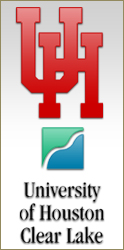 With rising demand for advanced physics degrees by the region’s NASA-related, petrochemical and high-tech industries, the University of Houston is making it easier for scientists in the Clear Lake area to earn a Ph.D. while working full time. With rising demand for advanced physics degrees by the region’s NASA-related, petrochemical and high-tech industries, the University of Houston is making it easier for scientists in the Clear Lake area to earn a Ph.D. while working full time.
A new collaborative program between UH and UH-Clear Lake that began this fall allows students to complete a Ph.D. in physics while satisfying some of the degree requirements at the Clear Lake campus. Both UH and Clear Lake faculty on the UH-CL campus will teach classes that count as part of the Ph.D. degree requirements at UH, but UH will confer the degree, said Lawrence Pinsky, chairman of the UH physics department.
Although UH-CL cannot offer doctorates, it does offer a master’s degree in physics. Some graduate classes taught on the UH-CL campus will satisfy the Ph.D. qualifying exam requirements in the UH program. Once admitted into this joint Ph.D. program, students will be able to complete much of the doctoral coursework at the Clear Lake campus.
UH physics professors will receive joint faculty appointments at Clear Lake and vice versa, Pinsky said. Both universities’ instructors will be able to serve on thesis committees.
This allows full-time professionals in the Clear Lake area to work on their degrees without having to drive regularly to downtown Houston for class.
“We’re trying to remove as many hurdles as possible and attract students who wouldn’t otherwise have entered the program,” Pinsky said.
Because of its proximity to NASA and the oil industry, UH-CL will likely draw full-time physicists hoping to expand their career opportunities with an advanced degree, he said.
While jobs are plentiful for those with just a bachelor’s degree in physics, those positions tend to be practical and engineering-related, Pinsky said. But a Ph.D. trains physicists to conduct original research, he added.
The program accommodates part-time students with busy schedules by holding classes in the evening and a more flexible time frame. While regular Ph.D. students typically take about five to seven years to complete the degree, part-time students like those at UH-CL could take as long as eight to nine years to finish if needed.
In some cases, it might actually be possible for a student’s thesis to be tied to a job-related research project, Pinsky said.
Pinsky hopes to have about five to 10 students in the UH-CL program, complementing the 85 or so regular doctoral students in physics at UH.
Demand is high for physics researchers in fields such as chip design, semiconductors, petrochemicals and medical imaging. A significant fraction of all physics Ph.D.s work in the private sector, Pinsky said.
There is even a budding econophysics field, which applies theoretical physics to economics and finance. Over the past few decades, about a tenth of all physics Ph.D.s have worked in the finance industry at some point in their careers, Pinsky said. |

